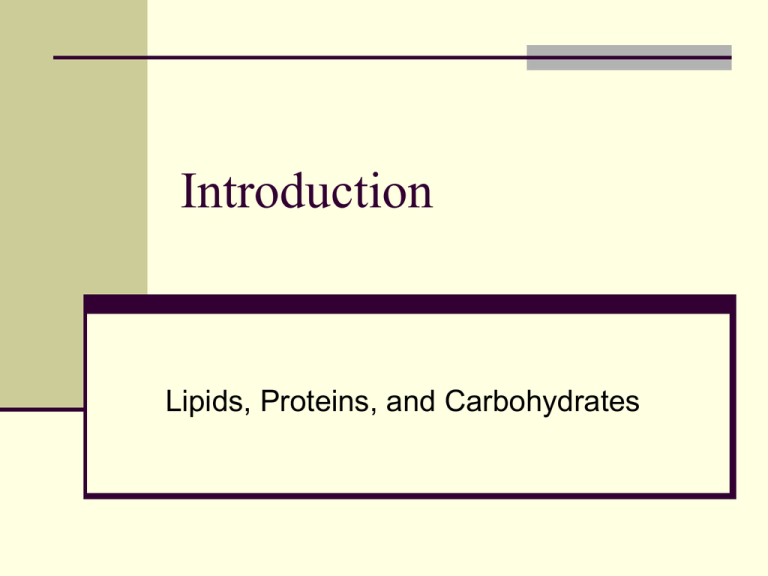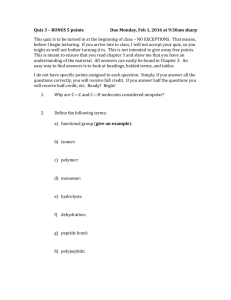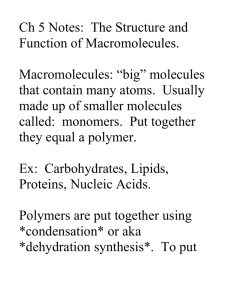Biochemistry
advertisement

Introduction Lipids, Proteins, and Carbohydrates Biochemistry Biochem is the study of biological materials Compounds of biological origin Chemistry of biological processes Biological materials are primarily made up of: Lipids Proteins Carbohydrates Lipids Fat-like compounds that leave grease mark Insoluble in water but soluble in organic solvents Fats are esters, reacting alcohol & organic acid produces ester Alcohol in fats is always glycerol, The organic acid obtained from fats is called fatty acid Fatty Acids Mono-carboxylic acids, -COOH Contain even number of H Have long & straight Carbon chain (20) Have 4 or less double bonds R1-COO-R1’ l R2-COO-R2’ A generic formula for a triglyceride l R3-COO-R3’ Oils Veg oils are liquid at room temp. (low melt point) VOs are less saturated than animal fats Less saturated oils has greater number of C=C Hydrogenation is adding H to C=C bonds to make the oil saturated (solid) Degree of unsaturation is normally measured by the Iodine number. It is grams of Iodine that is decolorized by 100 grams of fat. Hydrolyzing Fats Hydrolyzing fats with inorganic bases is called saponification (yields glycerol & soap) Sodium hydroxide makes hard soap and potassium hydroxide or ammonium hydroxide make soft soap. Fats become rancid when exposed to moist air, microorganisms act as catalysts to hyrolyze the fat Oxygen and ozone in the air oxidize the C=C bonds, producing aldehydes, acids, and peroxides that are the cause of rancid odor. Waxes Waxes that cover the fur and feather, and top of the shiny plant-leaf and beeswax are compound lipids that are also esters. Waxes like paraffin are pure hydrocarbons and NOT fats or esters. Proteins Introduction Proteins make up our muscles, skin, and the biological catalysts called enzymes Proteins do not accumulate in the body. Excess proteins breaks down in the body and get excreted in the H2N-C-NH2 form of urea: ll O We can manufacture protein through various bacteria Protein Structure Proteins are polymers They are formed like strings of beads Small units of protein chains is called amino acids About 20 amino acids make up all known proteins The amino acids have both amine group and the acid group attached to the same carbon atom (alpha amino acids) Alpha amino acid structure Chemical Structure of a common amino acid: H l H2N-C-COOH ll R1 R1 is the organic “tail” of the amino acid List of Amino Acids AMINO ACID THREE LETTER CODE SINGLE LETTER CODE glycine Gly G alanine Ala A valine Val V leucine Leu L isoleucine Ile I methionine Met M phenylalani ne Phe F tryptophan Trp AMINO ACID THREE LETTER CODE SINGLE LETTER CODE serine Ser S threonine Thr T cysteine Cys C tyrosine Tyr Y asparagine Asn N glutamine Gln Q aspartic acid Asp D glutamic acid Glu E W proline Pro P lysine Lys K arginine Arg R histidine His H Protein Polymers Forming a protein’s polymer chain involves a condensation reaction between an acid group (-COOH) and an amine group (-NH2), with water as a product. Structure of a 4 unit amino acid: Polypeptide Chains In a protein the polypeptide chain is the backbone of the molecule, holding it together by the covalent bonds (primary bonds) Known protein polymers contain from a few dozen to half-a-million amino acid units Proteins have a string-like secondary structure Alpha helix structure -- Coiled peptide Beta configuration ---- parallel strands Combined structures-- coiled, parallel, and tangled sections Hydrogen Bonds Hydrogen bond form between O and N atoms Alpha helix configuration is held in shape by H bonds between the C=O group on one loop and the N-H group across the way. H bonds are fairly weak. Any external force that breaks these bonds simultaneously destroys the secondary structure, causing the protein to denature For example heating and change in pH destroys H bond Changing Proteins thru Other Bonds Adding a substance that forms a stronger bond than H, it changes the shape of the protein. For example Lead and Mercury in human body denatures many of the essential proteins in the body Whole protein molecules cluster in a characteristic shape or structure. For example, tobacco mosaic virus molecules form a hollow tube Proteins are somewhat water soluble and can be classified as precipitating colloids







